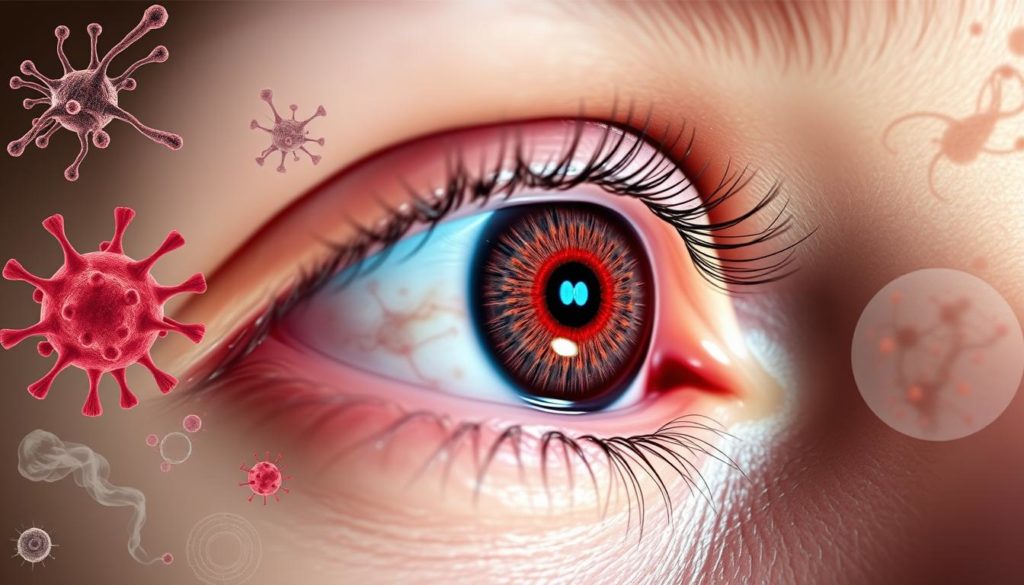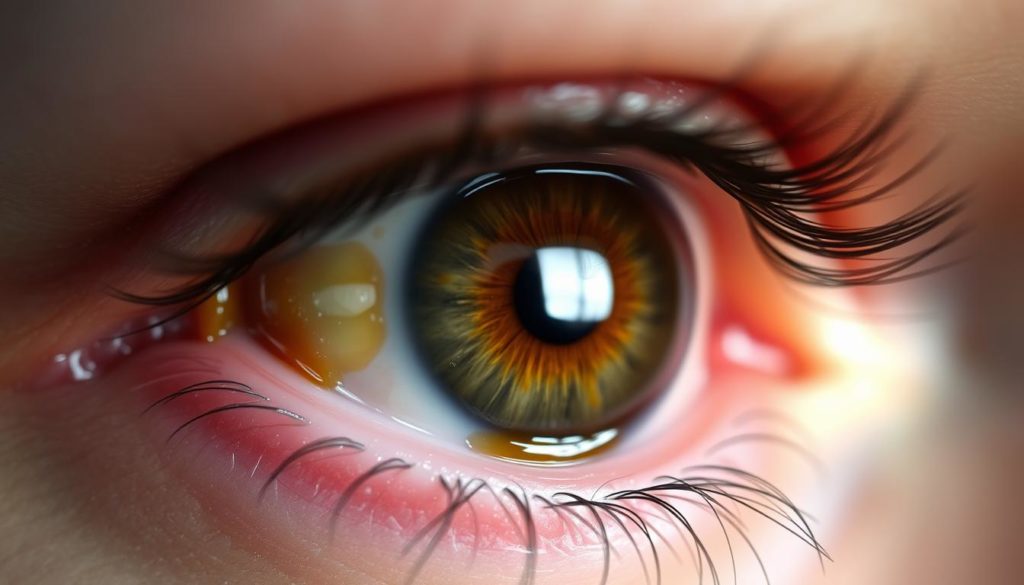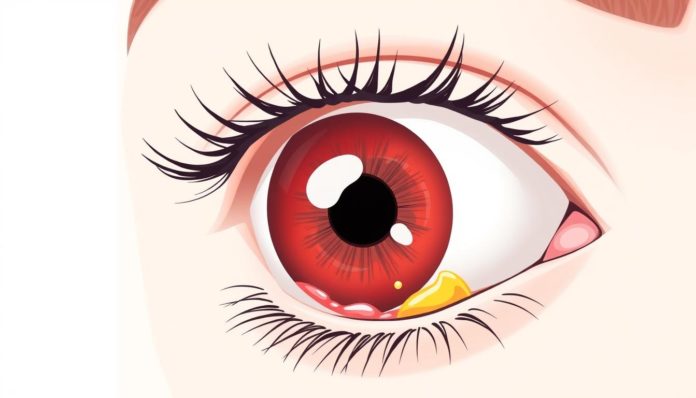Did you know almost 6 million people in the U.S. get pink eye yearly? This shows how common the condition is. Symptoms like redness and irritation are common. But, knowing them early helps stop the spread and eases discomfort.
Pink eye, also known as conjunctivitis, involves inflammation or infection. It affects the conjunctiva, a clear layer over your eyelid and eyeball. When blood vessels swell, it causes the red or pink color.
Finding pink eye signs early is key. Symptoms include itchiness, discharge, and being sensitive to light. Knowing these allows for quick action. Keep reading to learn about treating pink eye and maintaining healthy eyes.
What is Pink Eye?
Pink eye, also known as conjunctivitis, is a common eye condition. It involves inflammation or infection of the conjunctiva. The conjunctiva is a thin, clear tissue inside the eyelid that covers the eye’s white part. This causes redness and swelling.

Definition and Overview
Conjunctivitis has many causes, like viral and bacterial infections, allergens, and chemical exposure. Something in the eye or blocked tear ducts in newborns can also cause it. Symptoms vary based on the cause and can range from mild to severe. They can come with other symptoms like a cold or sore throat.
The Conjunctiva and Inflammation
The conjunctiva is a vital part of our eye health, acting as a protective barrier. When it gets inflamed from conjunctivitis, we see the classic “pink eye” look. Keeping good hygiene and avoiding irritants or infectious agents is key to prevention.
Allergic conjunctivitis is very common and happens due to allergen exposure. It causes sneezing and watery nasal discharge along with eye symptoms.
| Pink Eye Causes | Characteristics | Prevention |
|---|---|---|
| Viral Infections | Red, watery eyes, often with cold symptoms | Maintain good hygiene, avoid touching eyes |
| Bacterial Infections | Red eyes, pus-like discharge, crusting | Frequent hand washing, avoid sharing personal items |
| Allergens | Bilateral redness, itchiness, sneezing | Avoid known allergens, use air purifiers |
Common Causes of Pink Eye
Pink eye, known as conjunctivitis, has several causes. Learning about these helps in finding the right treatment. Let’s look at the main reasons:
Viral Infections
Viral infections are a key cause of pink eye. They include adenoviruses and herpes simplex virus. Accompanied by colds, viral conjunctivitis spreads easily through sneezing.

Bacterial Infections
Bacterial pink eye comes from bacteria like Staphylococcus aureus. Symptoms include a thick, yellow-green discharge. This type of pink eye spreads quickly, making early treatment important.
Allergies and Irritants
Allergies can trigger pink eye, due to things like pollen or pet dander. This leads to symptoms such as redness and itching in both eyes. Eye irritants, like chemicals, can also cause pink eye but usually heal fast.
- Viral Infections
- Adenoviruses
- Herpes Simplex Virus
- Varicella-Zoster Virus
- Bacterial Infections
- Staphylococcus aureus
- Streptococcus pneumoniae
- Allergies and Irritants
- Pollen
- Dust
- Pet dander
- Chemical splashes
- Foreign objects
| Cause | Characteristics | Treatment |
|---|---|---|
| Viral Infections | Redness, watery discharge, highly contagious | Antiviral medications, supportive care |
| Bacterial Infections | Thick yellow-green discharge, highly contagious | Antibiotic eye drops, proper hygiene |
| Allergies | Redness, itching, tearing, both eyes affected | Antihistamines, avoiding allergens |
| Irritants | Immediate redness, discomfort, usually resolves quickly | Rinse eyes thoroughly, avoid further exposure |
Pink Eye Symptoms
It’s key to spot pink eye symptoms early for quick treatment. Here, we outline three common signs of this illness.
Redness and Irritation
Redness is a clear pink eye sign. It comes from swollen blood vessels in your eye’s cover. This redness makes your eye feel gritty, as if something is in it.
Itchiness and Watery Eyes
Pink eye symptoms also include itchy, watery eyes. This happens a lot in allergic pink eye, making both eyes very itchy.
Discharge and Crusting
Discharge is a key sign of pink eye. Bacterial pink eye gives a thick discharge, leading to crusts after sleep. Viral causes, though, lead to runny discharge.
| Symptom | Description |
|---|---|
| Redness | Inflammation of blood vessels in the conjunctiva, causing a red appearance. |
| Itchiness | Often leading to excessive tearing, common in allergic conjunctivitis. |
| Discharge | Varies from watery to thick pus-like; more viscous in bacterial cases. |
How to Differentiate Between Types of Conjunctivitis
Knowing how to tell the difference between kinds of conjunctivitis is key. It helps find the right way to manage it. We will look at the main signs of viral, bacterial, and allergic conjunctivitis. We’ll also explore conjunctivitis from irritants.
Viral vs. Bacterial Conjunctivitis
To know the difference between viral and bacterial conjunctivitis, check the symptoms. Viral conjunctivitis usually starts in one eye with watery discharge. It might spread to the other eye, and you could feel like you have a cold. Bacterial conjunctivitis, meanwhile, shows up with thick discharge like pus. It might happen along with an ear infection. Knowing these signs helps treats pink eye right.
Allergic Conjunctivitis Characteristics
Allergic conjunctivitis is easy to spot with its unique signs. It affects both eyes with itching, swelling, and redness. Those with it might also sneeze a lot and have a stuffy nose. Spotting these signs is crucial, especially for people with allergies.
Conjunctivitis from Irritants
Conjunctivitis from irritants has its own symptoms. It causes watery discharge and mucus. This type happens when things like smoke, chemicals, or pool water irritate the eye.
| Type | Primary Symptoms | Associated Conditions |
|---|---|---|
| Viral Conjunctivitis | Watery discharge, one eye affected first, spreads to the other eye, cold/flu-like symptoms | Often follows a cold or respiratory infection |
| Bacterial Conjunctivitis | Thick, pus-like discharge, redness | May accompany ear infections |
| Allergic Conjunctivitis | Itching, redness, swelling, both eyes affected | Accompanied by sneezing and nasal congestion |
| Conjunctivitis from Irritants | Watery discharge, mucus | Exposure to smoke, chemicals, or pool water |
When to See a Doctor
Knowing when to see a doctor for pink eye is important. Severe symptoms like a lot of redness, sharp pain, feeling something in your eye, not seeing clearly, or being really sensitive to light need quick action. These signs could mean something serious. It’s best to get checked by a doctor for the right pink eye treatment.
Mild cases sometimes get better on their own. But don’t wait too long if symptoms are bad. They could show a bigger problem that needs fast treatment.
If you wear contact lenses, be careful when you get pink eye. Stop using them right away. If things don’t get better in 12-24 hours, see an eye doctor. They can check for worse infections. You might need special pink eye treatment based on what they find.
People with weaker immune systems should watch their symptoms closely. If you keep having problems like redness and swelling, you might need a stronger pink eye treatment plan. This helps avoid worse problems and heals faster.
To prevent pink eye, always stay clean, don’t share personal things, and see a doctor early if needed. Doing these things plus getting advice in time can control symptoms well. And it lowers the chance of more trouble.
Risk Factors for Developing Pink Eye
Knowing how pink eye starts is crucial for stopping or spotting it early. By learning about these risk factors, you can notice pink eye signs sooner. And you can take steps to avoid getting pink eye.
Exposure to Infected Individuals
Being near someone with pink eye raises your risk. This can happen from touching them, using the same stuff, or just being close. It’s very important to stay clean and keep away from people showing signs of pink eye.
Allergic Triggers
Allergies can also lead to pink eye, especially for those already sensitive. Allergens like pollen, dust mites, or pet dander can cause allergic pink eye. Keeping an eye on your surroundings and dealing with allergies is key to avoiding pink eye.
Contact Lens Use
For contact lens wearers, not taking care of your lenses can be risky. Bad cleaning and storing can bring on pink eye. Making sure your lenses are clean and following eye care tips are good ways to lower your risk.
Presence of these risk factors necessitates vigilance and adherence to preventive measures.
| Risk Factor | Description |
|---|---|
| Exposure to Infected Individuals | Close contact with people having viral or bacterial conjunctivitis. |
| Allergic Triggers | Exposure to allergens like pollen, dust mites, or pet dander. |
| Contact Lens Use | Improper contact lens hygiene and extended wear. |
Diagnostic Procedures
Doctors start figuring out pink eye by looking closely at symptoms and doing eye exams.
Symptoms Assessment
A healthcare provider will ask about your pink eye symptoms. They want to know when they began, how long they’ve lasted, and what they feel like. Knowing the details helps figure out if a virus, bacteria, or allergy is causing it.
Eye Examination Techniques
After talking about symptoms, the doctor will check your eyes. They use bright lights and special tools to see the conjunctiva and outside of your eye clearly. They might look deeper into your eye if they need more information.
If pink eye doesn’t get better with initial treatments, more tests might be done. This can include an eye culture to find the exact germ. They might also test your vision to see if pink eye has affected it. These steps help doctors treat pink eye correctly.
Treatment Options for Pink Eye
Treatment for pink eye, or conjunctivitis, depends on the cause. We aim to ease symptoms and fight the infection.
Home Remedies
For at-home care, warm compresses can reduce discomfort. Artificial tears available over-the-counter may help soothe irritation too.
Medications and Prescriptions
If home remedies don’t work, see a doctor for advice. For bacterial infections, antibiotics are the usual route. Antiviral medications are needed for herpetic conjunctivitis. In allergic cases, antihistamines or steroid drops can be used, especially if severe.
Specific Treatments Based on Cause
The treatment for pink eye should match its cause:
- Bacterial Conjunctivitis: Antibiotics to clear the infection.
- Viral Conjunctivitis: Antiviral drugs, especially against the herpes virus.
- Allergic Conjunctivitis: Antihistamines or steroid drops for harsh symptoms.
Always wait until you’re fully healed to wear contacts again. Make sure to replace them to avoid more infections. Below is a table comparing the different treatments:
| Cause | Treatment | Prescription Required |
|---|---|---|
| Bacterial | Antibiotics | Yes |
| Viral | Antivirals | Yes |
| Allergic | Antihistamines/Steroid Drops | Depends |
Home Remedies for Pink Eye
Several home remedies can ease pink eye symptoms. These measures comfort and prevent more irritation. Let’s explore some home-based treatments:
Warm and Cool Compresses
Warm or cool compresses can greatly relieve pink eye. A warm compress reduces discomfort and redness effectively. Meanwhile, a cool compress lessens swelling and eases itchiness. Soak a clean cloth in warm or cool water, squeeze out the extra, and place it gently over your closed eye for a few minutes.
Over-the-Counter Solutions
Artificial tears or eye drops from the store can soothe your eyes. They’re found easily at pharmacies and help with dryness and discomfort. These drops are a straightforward solution for treating pink eye at home.
Hygiene and Cleaning Tips
Good hygiene is key in handling pink eye and stopping its spread. Always wash your hands and don’t touch your eyes. Avoid using eye makeup until the infection is gone. If allergic conjunctivitis is the problem, stay away from allergens to prevent pink eye.
Also, use different towels and pillowcases to avoid infecting your family.
These home remedies can help you recover from pink eye faster. By applying these tips, you can manage and prevent this eye issue effectively.
FAQ
What are the symptoms of pink eye?
Pink eye makes your eyes red and swollen. You might feel like there’s sand in them. Itching, crusts on eyelashes from discharge, tearing, and light sensitivity can also happen. Cold or respiratory infection symptoms may occur too.
What causes pink eye?
Causes include viruses, bacteria, allergies, chemicals, or blocked tear ducts in babies. Viral and bacterial conjunctivitis spread easily. Allergies cause a different kind of pink eye.
How can I prevent pink eye?
Keep your hands clean and don’t touch your eyes. Don’t share items like towels or makeup. For contact lens wearers, clean and store lenses properly.
How is pink eye diagnosed?
Doctors check symptoms and look at your eyes with special lights. They might test eye fluid or your vision if they need more information.
What are the treatment options for pink eye?
Treatments depend on the pink eye cause. Home care includes warm compresses and eye drops. Doctors may prescribe antibiotics for bacteria, antivirals for viruses, or antihistamines for allergies. Bad cases might need steroid drops.
Are there home remedies for pink eye?
Yes. Warm compresses soothe, while cool ones lessen swelling and itch. Eye drops help, and keeping clean prevents spreading.
When should I see a doctor for pink eye?
Go to a doctor for severe redness, eye pain, blurry vision, or strong light sensitivity. Contact lens users should see a doctor if things don’t get better in 12-24 hours.
What are the risk factors for developing pink eye?
You’re at risk if you’re around someone with contagious pink eye or if you’re exposed to allergens. Bad contact lens care also raises the risk. Knowing this helps you avoid and catch pink eye early.
How do I differentiate between types of conjunctivitis?
Viral conjunctivitis often starts in one eye with watery discharge and signs of a cold. Bacterial conjunctivitis means thicker discharge possibly with an ear infection. Allergic conjunctivitis hits both eyes, causing big-time itching, sneezing, and runny nose.
How long does pink eye take to go away?
How long pink eye lasts varies. Viral and bacterial types usually get better in a week or two with the right treatment. Allergic pink eye sticks around as long as the allergen does. Pink eye from irritants often goes away in a day.


